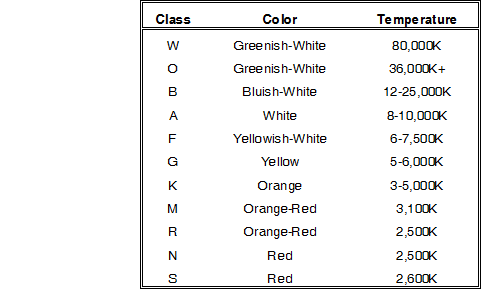Editing Star Information
Data for a star may be changed simply by typing the required information into the display boxes on the main screen. Existing information may be changed by overtyping it.
• |
To add a new entry, use the “Add” button or menu item. |
• |
To delete an entry, use the “Delete” button or menu. |
• |
To alter the ordering of entries, click on the up or down arrow of the spin button. |
It is also possible to use the “Cut”, “Copy”, “Paste” menu items to manipulate all the information relating to a single star entry via the Windows Clipboard. This is especially useful if you have two copies of the Star Editor running, in which case you can cut or copy entries in one file and paste them into another. (In order to run two copies of the Star Editor, you must start it independently from Solar Fire, using its own icon in the Solar Fire Group window)
Editable Items:-
• |
Traditional Name - The traditional name is the name by which the star (or astronomical point) is shown in the list of stars. For example, the brightest star in the constellation Eridanus is commonly known as Achenar. |
• |
Nomenclature - This is a standard technical name by which the star is known. There are several different systems of nomenclature in use, as listed below. This information is optional, and may be left blank. |
Bayer nomenclature - uses a Greek letter name which is unique in a particular constellation, denoting the relative brightness of the star. For example, Achenar is known as Alpha Eridanus. This indicates that it is the brightest star in the constellation Eridanus.
Flamsteed nomenclature - uses a number indicating the position in order of right ascension within a constellation. For example, Alcor is known as 80 Ursa Major.
Messier nomenclature - uses letter M plus a number for nebulous objects in a constellation. For example, Acumen is known as M7 Scorpius.
Greek Alphabet

• |
Constellation - The constellation in which the star (or astronomical point) resides can be selected from the list of available constellation names in the drop-down list box. This information is optional, and may be left blank. |
• |
NGC Number - NGC stands for New General Catalogue. It is a listing of observed celestial objects, and assigns a number to each one. For example, Achenar has NGC number 1979. This information is optional, and may be left blank. |
• |
Spectral Class - This indicates the quality of light emitted by the star. Typically it consists of a letter and a number. The letter indicates the general class, and the number (0-9) indicates where in that class it resides eg. A7 indicates white star with a yellowish tinge. The possible letters, in order of hottest stars to coolest stars are:- |

Sometimes there are also one or more small letters preceding or following the letter/number combination, as listed below. For example, gK7 indicates a giant orange star. This information is optional and may be left blank.
Letter Meaning

• |
Magnitude - This is a decimal number indicating the visual magnitude of the star. The lower the number, the brighter the star. Eg. the brightest star is Sirius, which has a magnitude of -1.4. The lowest visible magnitude is about 6. This information is optional and may be left blank. |
• |
Right Ascension and Declination - This is the position of the star in equatorial coordinates on the date specified in the Equator of Yr field. Right ascension may be entered either in Degrees, Minutes and Seconds, or in Hours, Minutes and Seconds of arc. However, it is always displayed in Hours, Minutes and Seconds. Declination is always entered and displayed in Degrees, Minutes and Seconds. For example, in 1950 Sirius was at a right ascension of 6h42m56.7s and at a declination of -16°38'46". These may be entered in any of the following ways. |
6h42m56.7s -16°38'46" or
6h42 56.7 -16d38 46 or
6 42 56.7 -16 38 46 or
100d44m10.5s -16d38m46s
Note that the first number entered in the Right Ascension field is assumed to be an hour number, unless the letter “d” appears somewhere in the entry, in which case the entry is assumed to be in degrees, minutes and seconds, and is automatically converted and displayed in the equivalent hours, minutes and seconds.
• |
Proper Motion - This is the annual motion of the star in right ascension and declination. The motion in right ascension must be entered in decimal seconds of Right Ascension (time). The motion in declination must be entered in decimal seconds of Declination (arc). For example, the proper motion of Sirius is -0.037 seconds of right ascension per year and -1.21 seconds of declination arc per year. |
• |
Equator of Yr - This is the “epoch” or year for which the entered right ascension and declination are applicable. Astronomical references usually contain star information for year 1950, or in more modern references, year 2000. |
• |
Keywords and Free Text - For each star, up to 30 characters of keywords or definition text may be entered, plus unlimited free text. The keyword text is used in Solar Fire’s star reports. The free text is also used in the Planetarium whenever star information is shown about any star. This information is optional and may be left blank. |
